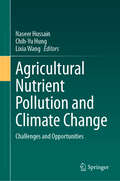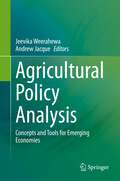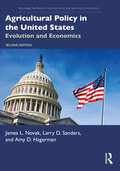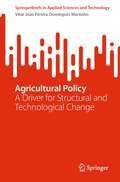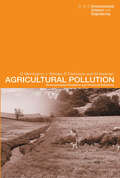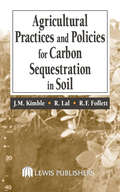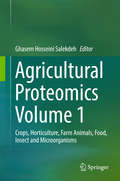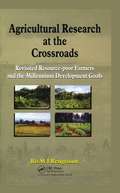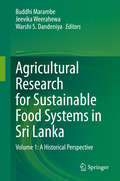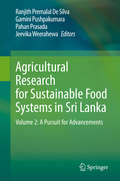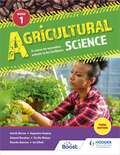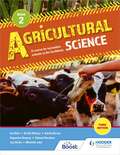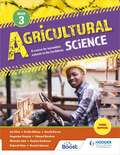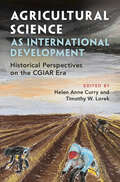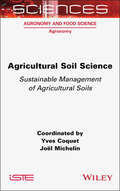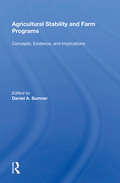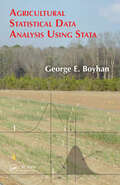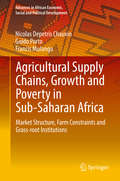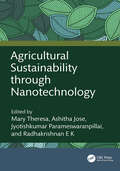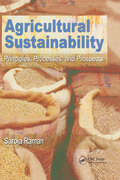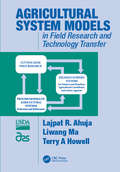- Table View
- List View
Agricultural Nutrient Pollution and Climate Change: Challenges and Opportunities
by Lixia Wang Naseer Hussain Chih-Yu HungThis book presents a comprehensive exploration of advanced scientific techniques for reducing agricultural nutrient pollution in the context of climate change. It delves into the sources, pathways, and extent of nutrient release into the environment, offering stakeholders valuable insights into how scientific advancements can help reduce environmental footprints. The authors critically examine key knowledge gaps, policy interventions, and challenges related to nutrient management from agrochemicals, synthetic fertilizers, and organic manures. As the demand for safe, sustainable, and environmentally friendly agricultural practices grows in the face of climate change, this book synthesizes scientific research, reports, and policies. It provides reliable information for scientists, students, policymakers, and organizations to promote effective nutrient utilization in agriculture while minimizing environmental impacts.
Agricultural Policy Analysis: Concepts and Tools for Emerging Economies
by Jeevika Weerahewa Andrew JacqueThis book is centred around various interwoven topics which are fundamental to policy analysis in agriculture. Key concepts and tools that are fundamental for the analysis of agricultural policies and programmes are presented. Key concepts introduced include, the role of the state in a market economy with examples from the Sri Lankan and other developing economies, the international trade environment, and conceptual frameworks for analysing important domestic and international trade policies. It also highlights interconnections among agriculture, development, policy and illustrates the extent to which the agricultural sector contributes in achieving economic growth objectives, equity and equality objectives and environmental objectives. The book takes the readers through the nature of agricultural markets in developing countries, with special emphasis on Sri Lanka, and illustrates how the degree of competitiveness is measured at various market levels using multiple indices and methods. Several tools, with accompanying case studies, for the analysis of policies and programmes are detailed. These tools include the GTAP model, gravity models, extended benefit cost analysis, and linear programming. Tools and models are applied to the analysis of trade policies and agreements, marketing policies, environmental services, extension programmes, land tenure reforms and climate change adaptations. Case studies in relation to the agri-food policy and strategy response to COVID-19 Pandemic are also covered. This book is of interest to public officials working in agricultural planning and agricultural policy, teachers, researchers, agro-economists, capacity builders and policymakers. Also the book serves as additional reading material for undergraduate and graduate students of agriculture, development studies, and environmental sciences. National and international agricultural scientists, policy makers will also find this to be a useful read.
Agricultural Policy in the United States: Evolution and Economics (Routledge Textbooks in Environmental and Agricultural Economics)
by James L. Novak Larry D. Sanders Amy D. HagermanAgricultural Policy in the United States: Evolution and Economics traces U.S. agricultural policy from its colonial roots to the present, using economic concepts to analyze and interpret political and economic consequences. It also examines the processes by which agricultural policies are developed, and the government structure which supports the implementation of legislation passed by Congress. The book includes arguments for and against common tools of U.S. agricultural policy, without influencing the reader in a particular direction. Each chapter contains questions and exercises to support students’ learning, and technical economic material is contained in optional appendices. This second edition examines the Agriculture Improvement Act of 2018 and sets the scene for future policy developments. Additionally, it looks at trade wars and the impact of Black Swan events like the COVID-19 pandemic on agricultural resilience.
Agricultural Policy: A Driver for Structural and Technological Change (SpringerBriefs in Applied Sciences and Technology)
by Vítor João MartinhoThis book gives insights into the agricultural policies in several countries located in different continents. It is of interest to students, researchers, and policy and decision makers.Given the particularities of agriculture, agricultural policies are indispensable for an adjusted development of farms according to the strategic objectives of each country, namely the socio-economic and environmental ones. The question that often arises is whether the practical effects of the various policy measures are in accordance with their design and what is the effect of these policy instruments among many other causes of structural and technological change. The aim of this book is to describe the main agricultural policies that have been implemented in countries such as the United States of America, Brazil, China, India, South Africa, Australia, as well as the European Union. It also aims to analyse the real impact of these policies on the structural and technological changes of farms in the European Union. As its methodology, the book considers bibliometric analysis, literature review and statistical approaches.
Agricultural Pollution: Environmental Problems and Practical Solutions
by R. Parkinson Graham Merrington Dr Linton Nfa Mark Redman L. WinderThis comprehensive text provides a concise overview of environmental problems caused by agriculture, (such as pesticide pollution and increased nitrate levels) and offers practical solutions to them. It is well illustrated and contains a fully-referenced introduction to the main contemporary agricultural pollution issues in the UK. It will help pro
Agricultural Practices and Policies for Carbon Sequestration in Soil
by R. Lal J. M. Kimble R. F FollettThe potential to mitigate greenhouse gas emissions and global climate change is one factor driving agricultural policy development of programs that might pay farmers for practices with a high potential to sequester carbon. With chapters by economists, policy makers, farmers, land managers, energy company representatives, and soil scientists, Agricu
Agricultural Proteomics Volume 2: Crops, Horticulture, Farm Animals, Food, Insect and Microorganisms
by Ghasem Hosseini SalekdehThis book will cover several topics to elaborate how proteomics may contribute in our understanding of mechanisms involved in stress adaptation. The knowledge being accumulated by a wide range of proteomics technologies may eventually be utilized in breeding programs to enhance stress tolerance. This book presents comprehensive reviews about responses of crop and farm animals to environmental stresses. Challenges related to stress phenotyping and integration of proteomics and other omics data have also been addressed.
Agricultural Research at the Crossroads: Revisited Resource-poor Farmers and the Millennium Development Goals
by Bo M. I. BengtssonIt is necessary to integrate field data relevant to policy with a global overview with up-to-date information for synthesis into scenarios and a vision of how future research and development in agriculture can best help those who are most needy and have little access to productive resources. The overall task is a huge challenge for policy-makers and the agricultural research establishment. It is also of concern in teaching agricultural students to be able to respond to future challenges. This publication is an attempt to stimulate discussion on future options of research policy, suggesting changes of agricultural R&D for societal development in accordance with the Millennium Development Goals.
Agricultural Research for Sustainable Food Systems in Sri Lanka: Volume 1: A Historical Perspective
by Buddhi Marambe Jeevika Weerahewa Warshi S. DandeniyaA food system comprises the entire range of actors and interlinked activities related to food production, processing, distribution, marketing and trade, preparation, consumption, and disposal. When a food system operates without compromising the needs of future generations, it is considered to be a “Sustainable Food System.” The present-day food systems in Sri Lanka are diverse, and the natural and physical environment, infrastructure, institutions, society and culture, and policies and regulations within which the food systems operate, as well as the technologies employed, have shaped their outcomes. Agricultural research is a key factor in terms of innovation and technological advances. Innovation has been the main driver of food systems’ transformation over the past few decades and will be critical to addressing the needs of a rapidly growing population in a context of climate change and scarcity of natural resources. In addition, agricultural research must help meet the rising demand for food at affordable prices. Comprising 17 chapters written by specialist(s) in their respective subject-areas, this Contributed Volume on “Agricultural Research for Sustainable Food Systems in Sri Lanka: A Historical Perspective” shares the scientific knowledge accumulated by the National Agricultural Research System of Sri Lanka, including universities, and offers recommendations on how to make food systems more sustainable in order to address the current needs of Sri Lankan society. It presents perspectives on four key thematic areas, namely: (i) Crop and animal production, management, and improvement, (ii) Agro-product processing technologies, (iii) Natural resource management, and (iv) Socio-economic development and agri-business management.
Agricultural Research for Sustainable Food Systems in Sri Lanka: Volume 2: A Pursuit for Advancements
by Jeevika Weerahewa Ranjith Premalal De Silva Gamini Pushpakumara Pahan PrasadaFood systems involve a range of activities concerning food production, processing, distribution, marketing and trade, preparation, consumption and disposal. They encompass the path of food from the farm to the dinner table, meeting the food and nutritional needs of a nation. When such systems do so without sacrificing the needs of future generations, they are referred to as “Sustainable Food Systems.” The natural and physical environment, infrastructure, institutions, society and culture, and policies and regulations within which they operate, as well as the technologies they adopt, shape these systems’ outcomes. Making food systems more sustainable is a key priority for all nations, and Sri Lanka is no exception. Food systems deliver optimal performance when the policy and regulatory environment is conducive, institutions are supportive, and a combination of agricultural research investments and an efficient extension system generates the technologies and scientific evidence required for sound policymaking and agenda setting. Further, agricultural research can generate essential findings, technologies and policies for sustainable agricultural development – across disciplines, sectors and stakeholder groups. This book shares valuable insights into research conducted in the broad food and agriculture sectors in Sri Lanka. It also discusses the status quo in related disciplines, and outlines future research directions. Accordingly, it offers a valuable source of reference material for researchers, students, and stakeholders in the food and agriculture sectors, while also highlighting the types of support that policymakers and other decision-makers can provide.
Agricultural Science Book 1: Third Edition
by Ian Elliott Amrith Barran Edmund Berahzer Ricardo Guevara Michelle John Augustine Vesprey Orville Wolsey Joy ClarkeCultivate an interest in the agricultural sector with a three-level secondary course designed specifically for the Caribbean.- Explore regional and global practices and developments in agriculture.- Review career options in an increasingly lucrative and essential sector.- Enhance understanding of the relevance of agriculture with a project-based approach to select topics.- Prepare for study at the CSEC level with a dedicated project-based chapter scalable to other topics and SBA research at the CSEC level.- Consolidate learning with clear chapter objectives and end of chapter evaluation.
Agricultural Science Book 1: Third Edition
by Ian Elliott Amrith Barran Edmund Berahzer Ricardo Guevara Michelle John Augustine Vesprey Orville Wolsey Joy ClarkeCultivate an interest in the agricultural sector with a three-level secondary course designed specifically for the Caribbean.- Explore regional and global practices and developments in agriculture.- Review career options in an increasingly lucrative and essential sector.- Enhance understanding of the relevance of agriculture with a project-based approach to select topics.- Prepare for study at the CSEC level with a dedicated project-based chapter scalable to other topics and SBA research at the CSEC level.- Consolidate learning with clear chapter objectives and end of chapter evaluation.
Agricultural Science Book 2: Third Edition
by Ian Elliott Amrith Barran Edmund Berahzer Ricardo Guevara Michelle John Augustine Vesprey Orville Wolsey Joy ClarkeCultivate an interest in the agricultural sector with a three-level secondary course designed specifically for the Caribbean.- Explore regional and global practices and developments in agriculture.- Review career options in an increasingly lucrative and essential sector.- Enhance understanding of the relevance of agriculture with a project-based approach to select topics.- Prepare for study at the CSEC level with a dedicated project-based chapter scalable to other topics and SBA research at the CSEC level. - Consolidate learning with a clear chapter objectives and end of chapter evaluation.
Agricultural Science Book 2: Third Edition
by Ian Elliott Amrith Barran Edmund Berahzer Ricardo Guevara Michelle John Augustine Vesprey Orville Wolsey Joy ClarkeCultivate an interest in the agricultural sector with a three-level secondary course designed specifically for the Caribbean.- Explore regional and global practices and developments in agriculture.- Review career options in an increasingly lucrative and essential sector.- Enhance understanding of the relevance of agriculture with a project-based approach to select topics.- Prepare for study at the CSEC level with a dedicated project-based chapter scalable to other topics and SBA research at the CSEC level. - Consolidate learning with a clear chapter objectives and end of chapter evaluation.
Agricultural Science Book 3: A course for secondary schools in the Caribbean Third Edition
by Ian Elliott Amrith Barran Edmund Berahzer Ricardo Guevara Michelle John Deborah Khan Romina Umaharan Augustine Vesprey Orville WolseyCultivate an interest in the agricultural sector with a three-level secondary course designed specifically for the Caribbean.- Explore regional and global practices and developments in agriculture.- Review career options in an increasingly lucrative and essential sector.- Enhance understanding of the relevance of agriculture with a project-based approach to select topics.- Prepare for study at the CSEC level with a dedicated project-based chapter scalable to other topics and the SBA research at the CSEC level.- Consolidate learning with clear chapter objectives and end of chapter evaluation.
Agricultural Science Book 3: A course for secondary schools in the Caribbean Third Edition
by Ian Elliott Amrith Barran Edmund Berahzer Ricardo Guevara Michelle John Deborah Khan Romina Umaharan Augustine Vesprey Orville WolseyCultivate an interest in the agricultural sector with a three-level secondary course designed specifically for the Caribbean.- Explore regional and global practices and developments in agriculture.- Review career options in an increasingly lucrative and essential sector.- Enhance understanding of the relevance of agriculture with a project-based approach to select topics.- Prepare for study at the CSEC level with a dedicated project-based chapter scalable to other topics and the SBA research at the CSEC level.- Consolidate learning with clear chapter objectives and end of chapter evaluation.
Agricultural Science as International Development: Historical Perspectives on the CGIAR Era
by Helen Anne Curry Timothy W. LorekFor more than fifty years, international aid for agricultural research has been shaped by an unusual partnership: an ad-hoc consortium of national governments, foreign aid agencies, philanthropies, United Nations agencies, and international financial institutions, known as CGIAR. Formed in 1971 following the initial celebration of the so-called Green Revolution, CGIAR was tasked with extending that apparent transformation in production to new countries and crops. In this volume, leading historians and sociologists explore the influence of CGIAR and its affiliated international research centres. Traversing five continents and five decades of scientific research, agricultural aid, and political transformation, it examines whether and how science-led development has changed the practices of farmers, researchers, and policymakers. Although its language, funding mechanisms, and decision-making have changed over time, CGIAR and its network of research centres remain powerful in shaping international development and global agriculture. This title is also available as Open Access on Cambridge Core.
Agricultural Soil Science: Sustainable Management of Agricultural Soils (ISTE Invoiced)
by Yves Coquet Joel MichelinSoils are a vital resource in agricultural production. This book aims to provide an overview of several topics concerning agricultural soil management. Without claiming to be exhaustive, it nevertheless provides a useful basis for understanding how agricultural soils function, and how to manage these functions within agroecosystems. Our approach to soils is multidisciplinary, ranging from natural sciences to human and social sciences. Agricultural Soil Science also highlights the characteristics of soils in specific geographical regions (Mediterranean soils, tropical soils) and environments (urban soils). The content of this book is based on the training programs run by its authors at the higher education establishments where they teach. At a time of ecological transition, soils must once again play a central role in the management of agroecosystems. This book sets out to play its part in making that happen.
Agricultural Stability And Farm Programs: Concepts, Evidence, And Implications
by Daniel A. SumnerThis book attempts to contribute to a fuller understanding of perennial issues underlying farm problems and agricultural policies in the United States thus contributing to better projections of policy effects, to better forecasts of policy changes, and perhaps to better policy for agriculture.
Agricultural Statistical Data Analysis Using Stata
by George BoyhanPractical statistics is a powerful tool used frequently by agricultural researchers and graduate students involved in investigating experimental design and analysis. One of the most widely used statistical analysis software packages for this purpose is Stata. The Stata software program has matured into a user-friendly environment with a wide variet
Agricultural Supply Chains and Industry 4.0: Technological Advance for Sustainability
by Stella Despoudi Konstantina Spanaki Oscar Rodriguez-Espindola Efpraxia D. ZamaniThis book explores the impact of industry 4.0 on agricultural supply chains, exploring how changes such as increased digitisation, automation, and the digital value chain, will impact food production globally.At a time when increasing population and environmental degradation puts stress on food supply chains, traditional farming operation models struggle to maintain both sustainability and transparency. Industry 4.0 could lead to digitalised ways of farming and agricultural production processes that will transform the traditional operating and process models to digital, data-intensive methods focusing on analytics and decision-making practices.This book aims to provider the reader with an understanding of the concept of Agriculture 4.0 in relation to supply chain management. Different applications of Agricultural 4.0 supply chains are discussed in relation to their respective advantages and disadvantages.Dr. Stella Despoudi is Lecturer in Operations and Supply Chan Management at Aston University and Adjunct Lecturer in Supply Chain Management at the University of Western Macedonia, Greece.Dr. Konstantina Spanaki is a Lecturer in Information Management at Loughborough University, UK.Dr. Oscar Rodríguez-Espíndola is a Senior lecturer in Operations and Supply Chain Management at Aston University and a member of the Aston CRISIS centre, UK.Dr. Efpraxia Zamani is a Senior Lecturer of Information Systems at the University of Sheffield, UK.
Agricultural Supply Chains, Growth and Poverty in Sub-Saharan Africa: Market Structure, Farm Constraints and Grass-root Institutions (Advances in African Economic, Social and Political Development)
by Nicolas Depetris Chauvin Guido Porto Francis MulanguThis book investigates if and how agricultural market structures and farm constraints affect the development of dynamic food and cash crop sectors and whether these sectors can contribute to economic transformation and poverty reduction in Africa. The authors map the current cash and food crops supply chains in six African countries, characterizing their markets structures and domestic competition policies. At the farm level, the book studies the constraints faced by small holders to increase productivity and break out of a vicious cycle in which low productivity exacerbates vulnerability to poverty. In a series of micro case studies, the project explores how cooperatives and institutions may help overcome these constraints. This book will appeal to scholars and policy makers seeking instruments to promote increased agriculture productivity, resolve food security issues, and promote agribusiness by diversifying exports and increasing trade and competitiveness.
Agricultural Sustainability through Nanotechnology
by Jyotishkumar Parameswaranpillai Ashitha Jose Theresa, Mary E K RadhakrishnanAgricultural Sustainability through Nanotechnology focuses on the innovative intersection of agriculture and nanotechnology, offering a comprehensive exploration of how nanotechnological applications are revolutionizing sustainable farming practices. This book is a pioneering work that not only elucidates the immense potential of nanotechnology in agriculture but also provides practical insights into its implementation for enhanced sustainability.With a focus on addressing pressing agricultural challenges, this book sets itself apart by bridging the gap between cutting-edge nanotechnology research and its real-world applications in sustainable agriculture for better productivity. Readers will discover a wealth of knowledge on how nanotechnology can optimize crop production, mitigate environmental impacts, and improve resource efficiency in farming practices.This book is essential reading for researchers, academics, and professionals in the fields of agriculture, nanotechnology, and environmental science. It serves as a valuable resource for readers seeking to understand and harness the momentum of nanotechnology for sustainable agricultural practices.
Agricultural Sustainability: Principles, Processes, and Prospects
by Saroja RamanTake a balanced look at ways to ensure food security and to work to erase hunger around the worldAgriculture is the most aggressively managed ecosystem. Agricultural Sustainability: Principles, Processes, and Prospects provides a comprehensive examination of all facets of agricultural sustainability, beginning with the history of the evolution of the concept to the present. Challenges to sustainability are clearly presented along with practical strategies to counter prospective problems. This vital resource considers options for the future, as well as reviewing past approaches for their value in today’s world.When one considers that the alternative to agricultural sustainability is the collapse of the world’s food systems, it is understood that compromise is impossible. Agricultural Sustainability takes a holistic approach to the issues that are involved in making agriculture ecologically sound, economically viable, and socially responsible around the world. The book is divided into three parts. Part One clarifies the concept of agricultural sustainability, bringing a rational and balanced view of the core elements. Part Two discusses ways to promote sustainability in the world, including practical scientific and technological processes for improving yields while ensuring food security for future generations. Part Three peers into future decades, reviewing the vision documents of international agencies, their perceptions and expectations for the years ahead, and present dysfunctional aspects in the current food system. The book is extensively referenced and includes figures and charts to clearly explain data.The book examines: the historic evolution of the concept of agricultural sustainability the combined effects of a multiplicity of agricultural systems concepts for validating the sustainability of a production system the role of natural capital in production the role of science and technology in sustainable use managing land, water, biodiversity, and energy quantitative approaches to measuring agricultural sustainability the current status of agricultureand predictions for its growth in the coming decades case studies of agricultural growth from India and China problemsand possibilitiesof creating a hunger-free world by the end of this century Agricultural Sustainability is crucial, enlightening reading for field workers in NGOs and agricultural extensions; personnel in local, national, and international developmental organizations; and educators and students of sustainable agricultural production, food security, rural development, environmental science, and the conservation of natural resources.
Agricultural System Models in Field Research and Technology Transfer
by Liwang Ma Lajpat R. Ahuja Terry A. HowellMost books covering the use of computer models in agricultural management systems target only one or two types of models. There are few texts available that cover the subject of systems modeling comprehensively and that deal with various approaches, applications, evaluations, and uses for technology transfer. Agricultural System Models in Field Res
